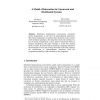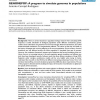828 search results - page 46 / 166 » A New Model of Program Dependences for Reverse Engineering |
Publication
This paper describes a new kind of genetic representation called analog genetic encoding (AGE). The representation is aimed at the evolutionary synthesis and reverse engineering of...
SIGSOFT
2010
ACM
13 years 6 months ago
2010
ACM
Almost all fundamental advances in science and engineering crucially depend on the availability of extremely capable high performance computing (HPC) systems. Future HPC systems w...
ARES
1998
Springer
14 years 1 months ago
1998
Springer
Distributed programming environments commonly restrict programmers to one form of intercomponent interaction. This forces programmers to emulate other interaction styles in terms o...
BMCBI
2008
13 years 9 months ago
2008
Background: There are several situations in population biology research where simulating DNA sequences is useful. Simulation of biological populations under different evolutionary...
SAC
2009
ACM
14 years 3 months ago
2009
ACM
Component-Based Development(CBD) is an emerging discipline for promoting practical reuse of software. In CBD, by building new software with independently developed components, we ...


